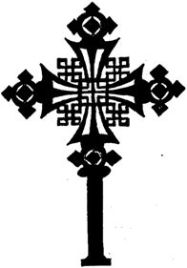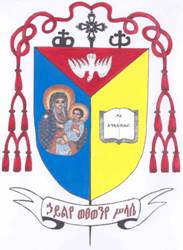Catholic Eparchy of Adigrat
"You will be my witnesses" (Luke 24:48; Act 1:8)

 |
Blessed Abba Gebremichael: a saintly disciple
Profile of the Eparchy of Adigrat
Eparchy of Adigrat |
Historical FoundationPope Gregory XVI appointed Mgr Justin de Jacobis Prefect Apostolic of Abyssinia on 10th March 1839. The boundaries of the Prefecture were stated as comprising "Ethiopia and the bordering countries without limits to both West and South." Now all the places previously mentioned (cf. 2.1.1), therefore, lay within his jurisdiction even when, on 19th June 1847 the Prefecture became the Apostolic Vicariate of Abyssinia despite the establishment in the previous year of the Apostolic Vicariate of the Sudan and the Apostolic Vicariate of the Galla. Mgr. J. de Jacobis,C.M. first settled in Adwa, where he arrived on 29th October 1839. Towards the middle of December that year Frs. Montuori and Sapeto left for Gonder. From there Fr. Montuori continued to Khartoum and Fr. Sapeto headed south with the intention of participating in Ras Sahle-Selassie's attempt to christianise the south of the country. For his part Mgr. de Jacobis remained in Adwa since it provided better opportunities for communications. After a year spent in studying languages, history and culture, he was asked to join the Ethiopian delegation heading for Cairo in the hope of obtaining a patriarch for Ethiopia. Once the patriarch had been obtained Mgr. de Jacobis with some other members of the delegation, notably Gebremichael, visited Rome and Jerusalem. As Adwa was not suitable for a permanent foundation, Mgr de Jacobis began looking elsewhere. Eventually, a piece of land was purchased at Guol'a on 10th December 1844, and he wrote: "I have chosen it to be our principal residence in Abyssinia." But from there in an attempt to avoid the threat of persecution and because the people gave him a cordial reception, which, in fact, was expressed in a covenant between the Catholic Church and the elders of the Irob people, he established roots at Alitena in 1845. The first ordinations were performed by Mgr. W. Massaia, O.F.M.Cap. on 2nd February 1847. Although the ordinations took place according to the Latin rite it was clearly understood that the priests belonged to and would exercise their ministry according to the Ethiopian rite. But, by contrast, Mgr. Massaia, who had interrupted his journey south where he was still to begin his ministry as Vicar Apostolic of the Galla, made it quite clear that he would "do everything possible to introduce Roman Catholic practices." On 19th June 1847 the Prefecture of Abyssinia became the Apostolic Vicariate of Abyssinia and Mgr. de Jacobis was appointed the bishop. His consecration by Mgr. Massaia took place in the greatest secrecy in a hut near Massawa' coast on the evening of 7th January 1849. Two years later, in 1851, Mgr. de Jacobis founded the parish of Maiberazio. The patriarch that had come from Cairo began a systematic persecution of the Catholics in that same year. Mgr. de Jacobis left the region for Halay in the hope that his absence would put an end to their sufferings. His presence at Halay was providential as it led to the establishment of new parishes throughout that region and also among the people around Keren. As the Vicariate had become so widespread, ranging from Gonder through Agame, the region around Halay and Hebo, as well as Massawa and Keren, Mgr. Biancheri was consecrated as coadjutor in the church of Halay on 2nd October 1853. Mgr. de Jacobis now felt free to pursue his intention of making an apostolic visit to Gojam and Shewa, as there was now a bishop to cater for the northern part of the Vicariate. While passing through Gonder, however, together with all his priests, he was imprisoned. After four months in prison Mgr de Jacobis was escorted into exile, but before reaching Metema the soldiers let him go, and it was only on 5th March 1855 that he returned to Halay. From then until his death on 31st July 1860 Mgr. de Jacobis lived the life of a hunted bishop. He had two concerns: to save his 12,000 or so Catholics from persecution and to ensure the continuity of the Vicariate. In the latter months of his life he had a great joy when Fr. Charles Delmonte, C.M. arrived in Halay on 12th January 1860. The bishop had really desired to restrict the number of European personnel to a minimum since he wanted to build up an Ethiopian Catholic Church based almost exclusively on Ethiopian diocesan priests. He trusted those priests and they responded with equal trust. Mgr. de Jacobis' legacy, therefore, in establishing a viable Ethiopian Catholic Church was founded on two cornerstones: mutual trust and the use of the Ethiopian rite. Mgr. de Jacobis was canonized on 26th October 1975. ©Copyright by Catholic Eparchy of Adigrat. All Rights Reserved |
